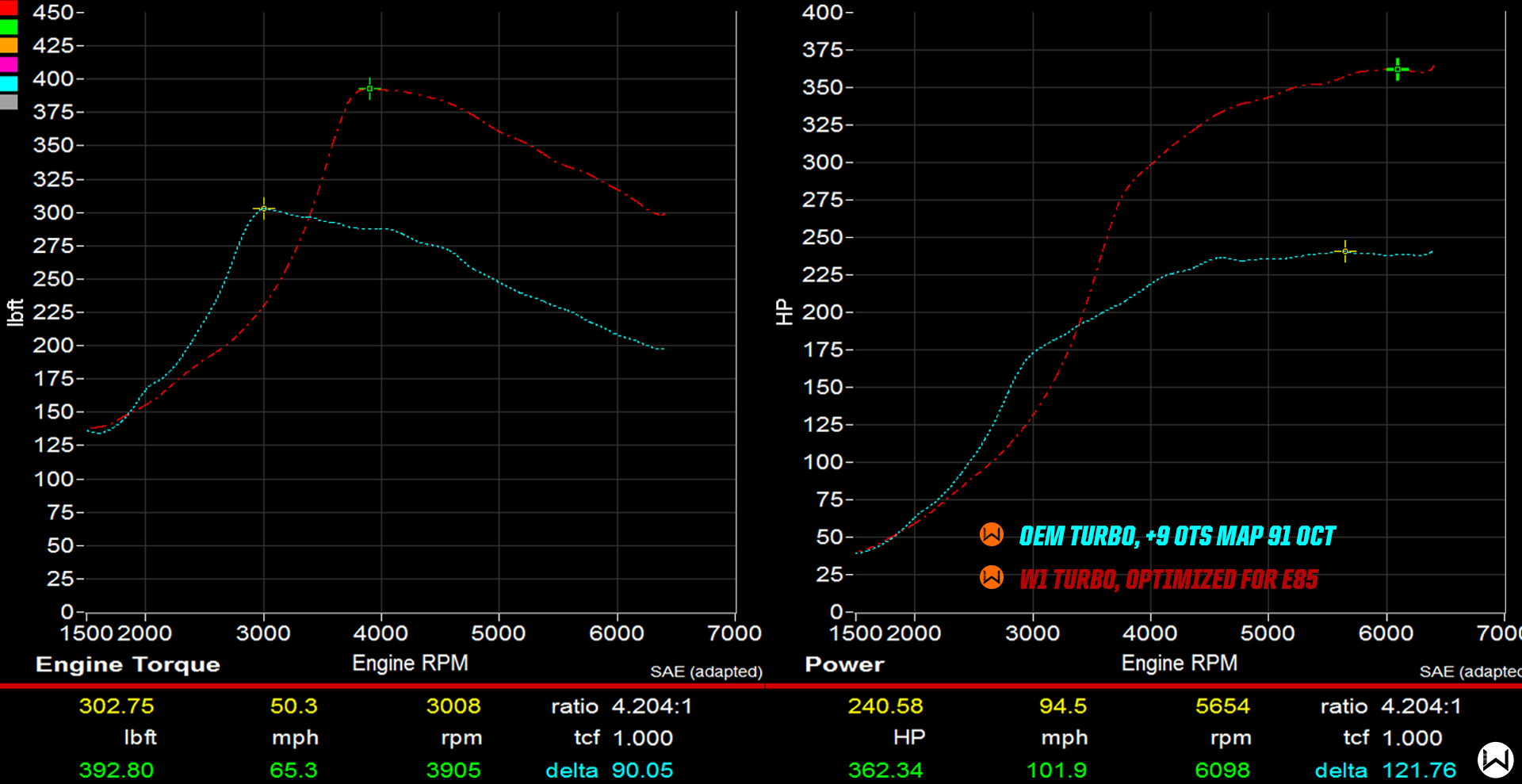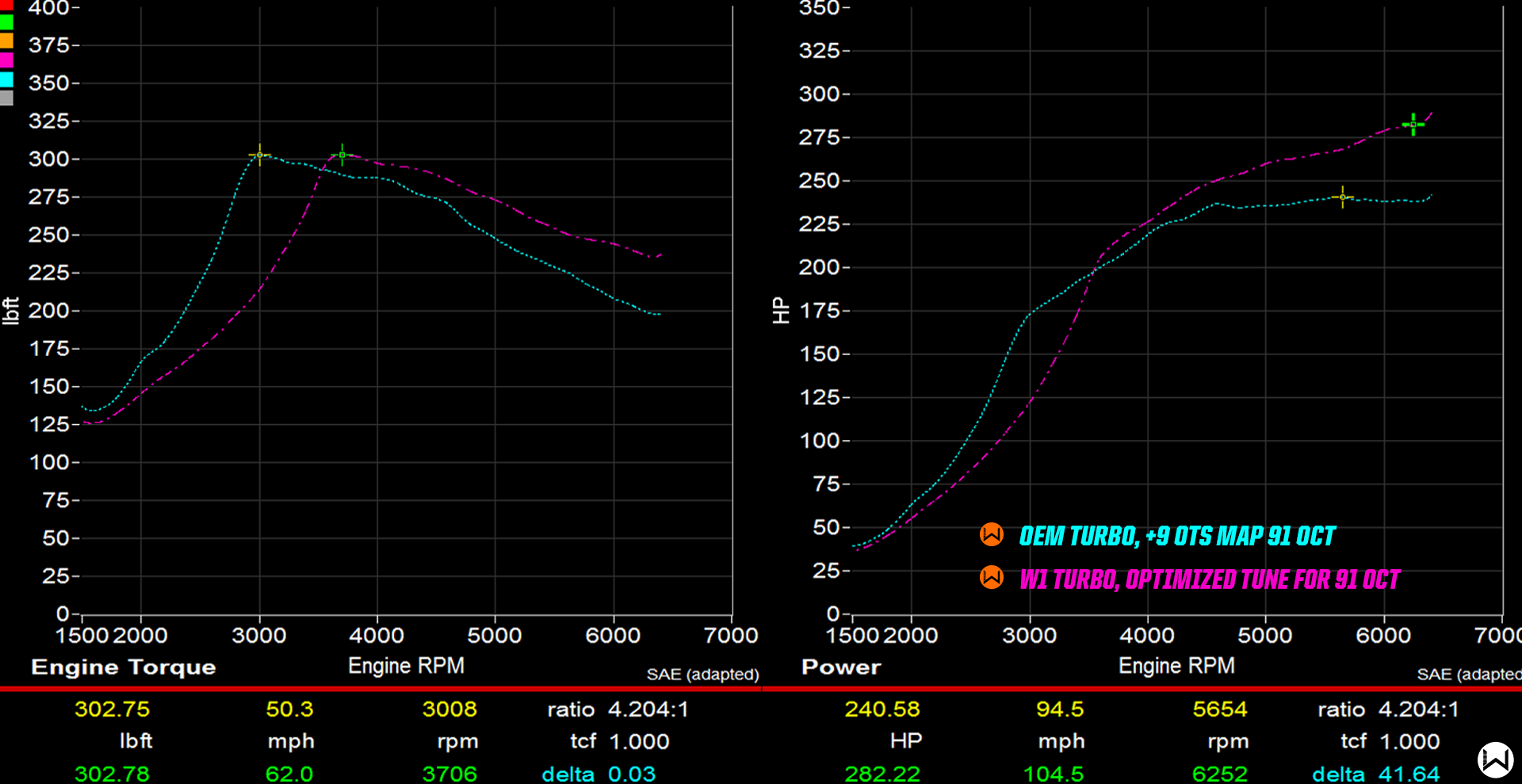The W1 Drop-In Turbocharger Pt.5 - POWER!!!!
A few weeks ago we dug into the wheel sizes of the 27WON W1 Performance Turbocharger that we have designed to be a true “drop-in” upgrade for your 2016+ Honda Civic 1.5L. Today we are going to talk about something we know you have been waiting for… the consideration of casting flow in mold design.
No we’re kidding; we won’t tease you any longer.
LET'S TALK POWER!!!!
Before we look at the numbers (don’t cheat!) let’s make something clear. A chassis dyno is a tool to measure, record, and compare wheel horsepower. Numbers are great but different dynos can output different numbers; we can bench race all day another time. What’s really important here is the delta, or the change in the numbers. Today, we are going to discuss the change in wHP and wTQ due to installation and tuning of our 27WON W1 Turbocharger for the 10th gen civic.
Beast Mode - Unlocked!!!
Damn look at that delta! +122wHP and +90wTQ from upgrading to our turbo along with a custom E85 tune. That is a 35% increase in wHP and 30% increase in wTQ. This is the extreme change in power! Let’s dig in and see how we accomplished this.
Note: All testing was performed on the same car, same modifications (minus the turbocharger), and same chassis dyno. The vehicle was outfitted with a cold air intake, upgraded intercooler and piping, catless downpipe/front-pipe combo and stock SI exhaust from the front-pipe back. The vehicle is an SI Sedan; therefore this testing comparison is between the OE (original) SI turbo and the 27WON W1 turbo. All tuning was performed with a Hondata FlashPro; similar results could be expected with a K-Tuner and other various tuning solutions. ***Note, turbo unit is rated at 27psi max working pressure, do not exceeded the operational limit of the unit or warranty will be void***
Phase 1
Variable: - Turbo Swap
Tune: OTS Map - Same for both turbos
Turbo: OE vs W1
The first test was performed with 91 octane fuel and is a direct comparison of turbo to turbo with no tuning changes utilizing the Hondata 9+psi OTS map. The blue line shows the OE turbo and green line is the 27WON turbo.
A smoother curve allows us to ease into the powerband and provides and extra level of safety to our engines bottom end.
With no tune change we see an increase in peak horsepower of 18wHP occurring around 400 rpm later than OE. This tells us the turbo is flowing more air at the same boost pressure and is able to fight the severe power drop off we see with the OE turbos. Looking at torque we see that peak has shifted 700rpm later and actually lost a small amount at 8wTQ. This is to be expected as an equivalent boost pressure at a higher RPM will make less torque. The torque having shifted 700rpm later is because of the larger wheels in the turbocharger. Larger and heavier wheels require more exhaust gas energy (higher RPM) to spool.
This isn’t really a bad thing though. Shifting the powerband of the engine higher in the RPM range helps reduce the stress on the engine internals and keep your engine running strong longer.
Phase 2
Variable: - Tune
Tune: OTS Map vs OTS Modified for W1
Turbo: W1
With the direct drop-in test performed we could see how much the turbo alone increased power, but now we wanted to see what some tuning optimization could do. Optimization of the tune included ignition timing changes, air/fuel mixture changes, and boost pressure increased from 23.7psi to 24.8psi. Again this is 91 octane fuel only. The green line shows the W1 with OTS tune and magenta line is again the W1 but with the OTS tune modified a bit.
The W1 is able to make peak power later in the RPM range giving us a much greater powerband to work with over the OEM turbo.
With a little bit of tuning we were able to smooth out the torque and also bump up the torque and horsepower curves over the entire RPM range. From drop-in to tuned, we see an increase of 24wHP and 8wTQ. This also tells us the 27WON W1 turbo can be installed and ran on an OTS map, but you will be leaving a lot of power on the table. A custom tune is highly recommended.
Phase 3
Variable: - Tune & Turbo
Tune: OTS Map vs OTS Modified for W1
Turbo: OE vs W1
Let’s combine the above two dyno graphs to see how far we’ve come over our baseline on the stock turbo. Below is the OE turbo with the Hondata 9+psi OTS map vs the 27WON W1 turbo with its new optimized OTS tune for an impressive gain of 42wHP and no loss in wTQ. The blue line shows the OE turbo and magenta line is the W1 with modified tune.
Notice how the W1 turbo continues to make power well after the OEM has gone flat.
Phase 4
Variable: - Turbo
Tune: Custom Ethanol
Turbo: OE vs W1
Now it’s time to throw some ethanol at it; and let’s just say the W1 Turbocharger loves octane and boost! Since there is not an OTS map for ethanol fuels, we had to start with a custom tune on the OE turbo to get our direct drop-in comparison. E85 allows for a tune with increased ignition timing. Boost pressure is set at 28psi peak. Air/fuel ratio is optimized for E85; for more on AFR check out our breakdown of fuel trims here. Notice that the stock turbo gained around 55 wHP with the switch to E85. Fuel Matters!!! The OE turbo is the blue line and 27WON W1 is the dashed gray line.
The L15 turbo engine found in the 10th generation Honda's responds very well to ethanol blended fuels.
Like the 91 octane testing, we again see the peak torque coming in later with the W1 turbo. Peak torque is nearly the same with a small increase of 2wTQ, but the horsepower increase is the real game changer. Peak to peak we see an increase of 52wHP, but that’s not the whole story. At this boost level we can really see the 27WON W1 Turbocharger triumph over the OE turbo because it keeps making more and more power as RPM increases vs the OE turbo which falls off after 5500rpm. Remember this is still just the drop-in results; the tune is the same for both turbos.
Let’s look at the first graph again to see what all this adds up to.
Phase 5
Variable: - Turbo & Tune
Tune: OTS 91 Octane vs Custom Ethanol W1
Turbo: OE vs W1
With fuel, tuning, and the W1 turbo upgrade you can pull some serious power out of the CivicX
The OE turbo on 91 octane is the blue line and 27WON W1 on a custom Ethanol tune is the red line. Since the larger W1 turbocharger is more efficient than the OE turbo it can allow for more aggressive ignition timing and can carry higher boost longer so that’s exactly what we did. Adding a little more timing and bringing boost up to 29psi gave us another increase in overall power; +13wHP and +16wTQ. Unfortunately the OE MAP sensor hits capacity at 3.2bar (31.7psi) but really starts to lose accuracy at 29psi. For this reason we stopped testing at 29psi.
+122 Wheel Horsepower, +90 Wheel Torque
So let’s look back at the big picture here: You are a month away from your 27WON W1 “drop-in” fitment performance turbocharger that will work with almost any performance parts you’ve already invested in, there is no core charge or waiting for modification. This turbo is designed 100% from scratch with brand new housings and a performance CHRA, it comes with all the needed gaskets and hardware to install, we provide full color interactive install instructions, and it’s possible to bump power a whopping +122wHP and +90wTQ with supporting modifications, and there is still the possibility to make a bit more.
It’s going to be the longest month ever for your Honda Civic…
Thanks for tuning in with 27WON Performance.
I dare you to REDEFINE
-Barett@27WON






